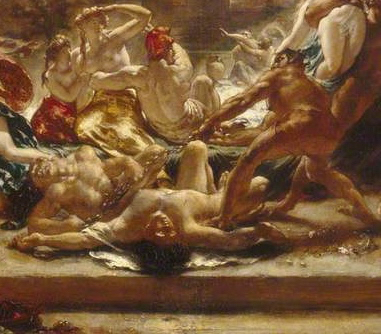Facts About The Destroying Angel and Daemons of Evil Interrupting the Orgies of the Vicious and Intemperate
"The Destroying Angel and Daemons of Evil Interrupting the Orgies of the Vicious and Intemperate" commonly known as "The Destruction of the Temple of Vice" is a dramatic oil painting by the English artist William Etty, completed in 1832. Measuring 127.8 cm by 101.9 cm, this striking work depicts a classical temple under assault by a fierce angel and menacing demons. The chaotic scene features a mix of deceased or unconscious figures, along with others desperately fleeing or battling the demonic forces.
William Etty, renowned for his depictions of the nude form, frequently faced criticism for his perceived indecency and lack of taste. With "The Destroying Angel" he aimed to craft a morally compelling piece to quell his critics. Upon its exhibition in 1832, the painting garnered acclaim for its technical prowess, although reactions to its theme were mixed. Some viewers admired its fusion of terror and beauty, while others found the subject matter inappropriate. Regardless, the painting marked a turning point for Etty, revealing a depth in his artistry that had previously been unrecognized by some critics.
Etty's emphasis on the nude form was pioneering in England, a society constrained by strict social norms and censorship. Despite frequent backlash for his portrayals of female nudity, Etty continuously pushed the boundaries of art. "The Destroying Angel" drew inspiration from various sources, including the works of John Milton and Alexander Pope, as well as the turbulent French Revolution of 1830, which Etty witnessed firsthand during a visit to Paris.
The painting's composition is a tumultuous blend of human and demonic figures engaged in dramatic conflict within the temple. The central figure, an imposing angel enshrouded in smoke, commands the scene, evoking a sense of chaos and dread. Upon its debut, the painting was well-received, with some likening it to the masterpieces of Rubens and Michelangelo.
Despite the initial acclaim, Etty continued to face criticism for his focus on nude subjects. He later endeavored to infuse his paintings with moral messages, but he remained a contentious figure. Over time, Etty's popularity waned, and his influence on subsequent artists was limited. "The Destroying Angel" was ultimately acquired by Sir Joseph Whitworth and donated to the Manchester Art Gallery, where it continues to be displayed.
While Etty's style fell out of favor over time, his work did inspire artists like William Edward Frost and John Everett Millais. However, his overall impact on the art world was modest, and his stylistic influence did not persist. Nonetheless, Etty's legacy endures through his significant contributions to the art of nude painting and his efforts to challenge societal conventions.

 Ireland
Ireland